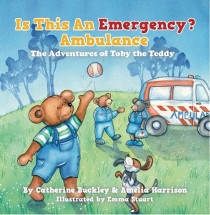Is this an emergency? Ambulance. The adventures of Toby the Teddy by Catherine Buckley and Amelia Harrison

Ill. by Emma Stuart. Amelia Harrison, 2016. ISBN 9780646952901
(Ages: 4-6) Medical emergencies, ambulances. An Australian primary
school teacher and an illustrator with experience in emergency
medical services have created this book to fill a specific
educational resource gap. They particularly wanted to address the
high number of prank and hoax calls that young children make to
emergency services. It is aimed at preschool and school age children
but because of its cutesy, somewhat babyish illustrations and tone
it has a limited audience (despite it being a topic that pertains to
much older children as well). I can't help but think that most prank
calls come from children slightly older than this book will appeal
to. The book follows Teddy (a teddy bear) as he faces problems and
shows how he deals with them, each time asking the reader 'Is this
an emergency?' and then explaining what Teddy should do next. It
uses examples that will be familiar to children in the target
audience and that are the most likely and critical medical
emergencies they may encounter in the schoolyard or at home (asthma,
anaphylaxis). The examples illustrate that different actions are
appropriate in different emergencies and familiar adults and
teachers are put forward as examples of people who can help rather
than it always being necessary to call an ambulance. Importantly
though, it is stressed that if no other adult is close by an
ambulance should be called. This will stimulate important
conversations about whether children know their home address and how
to phone an ambulance in an emergency. There are notes in the back
for teachers and parents, including discussion points and activity
ideas. The book is written in a non-frightening way and the language
used is clear and appropriate for young children. It gives children
a language to talk about medical emergencies (allergic reaction,
rash, can't catch his breath, etc.) and Teddy is a perfect
clear-thinking role model. Despite the whole thing feeling a bit old
fashioned (even the telephone depicted is an old wall-mounted
landline . . . with a cord!) it does fill a resource gap and would
be a useful resource for teachers and parents of preschool and
primary aged children, especially in classrooms or families where
there are children with medical conditions.
Nicole Nelson